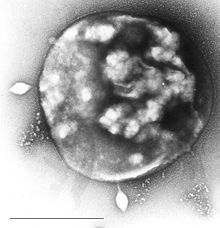Sulfolobales
| Sulfolobales | |
|---|---|

| |
| Electron micrograph ofSulfolobusinfected withSulfolobusvirusSTSV1.Bar = 1 μm. | |
| Scientific classification | |
| Domain: | Archaea |
| Kingdom: | Proteoarchaeota |
| Superphylum: | TACK group |
| Phylum: | Thermoproteota |
| Class: | Thermoprotei |
| Order: | Sulfolobales Stetter, 1989 |
| Family | |
Sulfolobalesis anorderofarchaeansin the classThermoprotei.[1]
Phylogeny
[edit]The currently accepted taxonomy is based on theList of Prokaryotic names with Standing in Nomenclature(LPSN)[2]andNational Center for Biotechnology Information(NCBI)[1]
| 16S rRNA basedLTP_06_2022[3][4][5] | 53 marker proteins basedGTDB08-RS214[6][7][8] | |||||||||||||||||||||||||||||||||||||||||||||||||||||||||||||||||||||
|---|---|---|---|---|---|---|---|---|---|---|---|---|---|---|---|---|---|---|---|---|---|---|---|---|---|---|---|---|---|---|---|---|---|---|---|---|---|---|---|---|---|---|---|---|---|---|---|---|---|---|---|---|---|---|---|---|---|---|---|---|---|---|---|---|---|---|---|---|---|---|
|
|
DNA transfer
[edit]Exposure ofSulfolobus solfataricusto the DNA damaging agentsUV-irradiation,bleomycinormitomycin Cinduces cellular aggregation.[9]Other physical stressors, such as pH or temperature shift, do not induce aggregation, suggesting that induction of aggregation is caused specifically by DNA damage. Ajon et al.[10]showed that UV-induced cellular aggregation mediates chromosomal marker exchange with high frequency. Recombination rates exceeded those of uninduced cultures by up to three orders of magnitude. Frols et al.[9][11]and Ajon et al.[10]hypothesized that the UV-inducible DNA transfer process and subsequenthomologous recombinationalrepair represents an important mechanism to maintain chromosome integrity. This response may be a primitive form of sexual interaction, similar to the more well-studied bacterial transformation that is also associated with DNA transfer between cells leading to homologous recombinational repair of DNA damage.[citation needed]In another related species,Sulfolobus acidocaldarius,UV-irradiation also increases the frequency of recombination due to genetic exchange.[12]
Theupsoperon
[edit]This sectionis missing informationabout illustration ofupsorganization (with UniProt IDs).(May 2020) |
Theups(UV-induced pilus) operon ofSulfolobusspecies is highly induced by UV irradiation. Thepiliencoded by this operon are employed in promoting cellular aggregation, which is necessary for subsequent DNA exchange between cells, resulting inhomologous recombination.[13]
A study of theSulfolobales acidocaldarius upsoperon showed that one of the genes downstream of the operon,saci-1497,encodes anendonucleaseIII that nicks UV-damaged DNA; and another gene of the operon,saci-1500,encodes aRecQ-like helicasethat is able to unwind homologous recombination intermediates such asHolliday junctions.[13]It was proposed that Saci-1497 and Saci-1500 function in an homologous recombination-based DNA repair mechanism that uses transferred DNA as a template.[13]Thus it is thought that theupssystem in combination with homologous recombination provide a DNA damage response which rescuesSulfolobalesfrom DNA damaging threats.[13]
See also
[edit]References
[edit]- ^abSayers; et al."Sulfolobales".National Center for Biotechnology Information(NCBI) taxonomy database.Retrieved10 May2023.
- ^J.P. Euzéby."Sulfolobales".List of Prokaryotic names with Standing in Nomenclature(LPSN).Retrieved10 May2023.
- ^"The LTP".Retrieved10 May2023.
- ^"LTP_all tree in newick format".Retrieved10 May2023.
- ^"LTP_06_2022 Release Notes"(PDF).Retrieved10 May2023.
- ^"GTDB release 08-RS214".Genome Taxonomy Database.Retrieved10 May2023.
- ^"ar53_r214.sp_label".Genome Taxonomy Database.Retrieved10 May2023.
- ^"Taxon History".Genome Taxonomy Database.Retrieved10 May2023.
- ^abFröls S, Ajon M, Wagner M, Teichmann D, Zolghadr B, Folea M, Boekema EJ, Driessen AJ, Schleper C, Albers SV (2008)."UV-inducible cellular aggregation of the hyperthermophilic archaeon Sulfolobus solfataricus is mediated by pili formation"(PDF).Mol. Microbiol.70(4): 938–52.doi:10.1111/j.1365-2958.2008.06459.x.PMID18990182.
- ^abAjon M, Fröls S, van Wolferen M, Stoecker K, Teichmann D, Driessen AJ, Grogan DW, Albers SV, Schleper C (2011)."UV-inducible DNA exchange in hyperthermophilic archaea mediated by type IV pili"(PDF).Mol. Microbiol.82(4): 807–17.doi:10.1111/j.1365-2958.2011.07861.x.PMID21999488.
- ^Fröls S, White MF, Schleper C (2009). "Reactions to UV damage in the model archaeon Sulfolobus solfataricus".Biochem. Soc. Trans.37(Pt 1): 36–41.doi:10.1042/BST0370036.PMID19143598.
- ^Wood ER, Ghané F, Grogan DW (1997)."Genetic responses of the thermophilic archaeon Sulfolobus acidocaldarius to short-wavelength UV light".J. Bacteriol.179(18): 5693–8.doi:10.1128/jb.179.18.5693-5698.1997.PMC179455.PMID9294423.
- ^abcdvan Wolferen M, Ma X, Albers SV (2015)."DNA Processing Proteins Involved in the UV-Induced Stress Response of Sulfolobales".J. Bacteriol.197(18): 2941–51.doi:10.1128/JB.00344-15.PMC4542170.PMID26148716.
Further reading
[edit]Scientific journals
[edit]- Judicial Commission of the International Committee on Systematics of Prokaryotes (2005)."The nomenclatural types of the orders Acholeplasmatales, Halanaerobiales, Halobacteriales, Methanobacteriales, Methanococcales, Methanomicrobiales, Planctomycetales, Prochlorales, Sulfolobales, Thermococcales, Thermoproteales and Verrucomicrobiales are the generaAcholeplasma,Halanaerobium,Halobacterium,Methanobacterium,Methanococcus,Methanomicrobium,Planctomyces,Prochloron,Sulfolobus,Thermococcus,ThermoproteusandVerrucomicrobium,respectively. Opinion 79 ".Int. J. Syst. Evol. Microbiol.55(Pt 1): 517–518.doi:10.1099/ijs.0.63548-0.PMID15653928.
- Driessen, Arnold; Yang, Nuan (January 8, 2014). "Deletion of cdvB paralogous genes of Sulfolobus acidocaldarius impairs cell division".Extremophiles.18(2): 331–339.doi:10.1007/s00792-013-0618-5.PMID24399085.S2CID14445065.
- Euzeby JP; Tindall BJ (2001)."Nomenclatural type of orders: corrections necessary according to Rules 15 and 21a of the Bacteriological Code (1990 Revision), and designation of appropriate nomenclatural types of classes and subclasses. Request for an Opinion".Int. J. Syst. Evol. Microbiol.51(Pt 2): 725–727.doi:10.1099/00207713-51-2-725.PMID11321122.
- Cavalier-Smith, T (2002)."The neomuran origin of archaebacteria, the negibacterial root of the universal tree and bacterial megaclassification".Int. J. Syst. Evol. Microbiol.52(Pt 1): 7–76.doi:10.1099/00207713-52-1-7.PMID11837318.
Scientific books
[edit]- Reysenbach, A-L (2001)."Class I. Thermoprotei class. nov.".In DR Boone; RW Castenholz (eds.).Bergey's Manual of Systematic Bacteriology Volume 1: The Archaea and the deeply branching and phototrophic Bacteria(2nd ed.). New York: Springer Verlag. p.169.ISBN978-0-387-98771-2.
- Stetter, KO (1989). "Order III. Sulfolobales ord. nov. Family Sulfolobaceae fam. nov.". In JT Staley; MP Bryant; N Pfennig; JG Holt (eds.).Bergey's Manual of Systematic Bacteriology.Vol. 3 (1st ed.). Baltimore: The Williams & Wilkins Co. p. 169.
